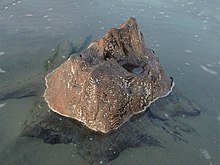Submerged forest



A submerged forest is the in situ remains of trees (especially tree stumps) that lie submerged beneath a bay, sea, ocean, lake, or other body of water. These remains have usually been buried in mud, peat or sand for several thousand years before being uncovered by sea level change and erosion and have been preserved in the compacted sediment by the exclusion of oxygen.[2] A forest can become submerged as the result of a lake or sea level rise that results in a lacustrine or marine transgression and in-place drowning of the forest. A submerged forest that lies beneath a lake can also be formed by the blockage of a river valley by either a landslide or manmade dam.
Examples
The examples and perspective in this section deal primarily with the Anglophone countries and Europe and do not represent a worldwide view of the subject. (August 2019) |
Marine submerged forests may be regularly exposed at low tide; examples of these can be found at low tide on the fringes of the submerged landmass known as Doggerland,[3] around the coast of England and the coasts of Wales,[4] the Channel Islands,[3] north-west France and Denmark. In some places, such as Blackpool Sands, Dartmouth, the remains are normally covered by sand and only rarely exposed.[5] During the storms of 1974 (see Penparcau) [6][7] and the Winter storms of 2013–14 in the United Kingdom extensive remains of submerged forests were revealed in a number places around the coast of Britain.[8][9]
As the North American Laurentide Ice Sheet began receding for the last time some 10,000 years ago, water levels in the future Great Lakes were sometimes much lower than at present. Forests once covered the southern end of what is now Lake Huron but as the glaciers melted and waters rose these forests were inundated and drowned. Today their remnants, well preserved logs and stumps, have been discovered in waters over 200 feet deep.[10][11]
Another submerged forest has been found in Nantucket Sound, off the coast of Massachusetts.[12] and in 2012 a submerged bald cypress forest, which has been dated at around 50,000 years old, was discovered in the Gulf of Mexico off the coast of Alabama.[2]
See also
References
- ^ *Reid, C., 1913. Submerged Forests. The Cambridge Manuals of Science and Literature, Cambridge University Press, 129 pp.
- ^ a b Holley, Peter (29 June 2017). "A mysterious underwater forest warns of Earth's rapidly changing climate". The Washington Post. Retrieved 14 January 2018.
- ^ a b Keith, Arthur (15 Aug 2004). "3". The Antiquity of Man. Anmol Publications Pvt Ltd. p. 41. ISBN 978-81-7041-977-8.
- ^ Campbell, J.A.; Baxter M.S. (29 March 1979). "Radiocarbon measurements on submerged forest floating chronologies". Nature. 278 (5703). Nature Publishing Group: 409–413. doi:10.1038/278409a0.
- ^ Pengelly, W (1869). Report and transactions, Volume 3: Devonshire Association for the Advancement of Science, Literature, and Art. Vol. 3. Cornwall, UK: W. Brendon and son. pp. 127–129.
- ^ Evans, J.G., Limbrey, S. and Cleere, H. (eds) 1975. The effect of man on the landscape: the Highland Zone. CBA Research Report No 11 (1975)
- ^ "Tanybwlch submerged forest". Coflein. Retrieved 11 June 2017.
- ^ Owen, Cathy (21 February 2014). "In pictures: The Bronze Age forest revealed in more detail than ever before by Wales' brutal storms". Wales online. Wales online. Retrieved 20 April 2014.
- ^ Lock, WBJ (20 February 2014). "Storms reveal ancient submerged forest at Portreath". West Briton. Local World. Retrieved 20 April 2014.
- ^ "Project Drowned Forest — A study of prehistoric undersater forests in Lake Huron, Michigan" (PDF). www.vibracoring.com. Retrieved 11 June 2017.
- ^ "DFProject website". www.vibracoring.com. Retrieved 11 June 2017.
- ^ Daley, Beth (6 November 2009). "Nantucket Sound may get new status". The Boston Globe. Boston Globe. Retrieved 12 January 2010.
Further reading
- An early work on this subject was: "Submerged Forests", by Clement Reid F.R.S., published by Cambridge University Press in 1913.
- See also, for example, "Submarine Archaeology of the North Sea", published by English Heritage in 2004, ISBN 1-902771-46-X
